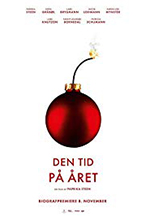A Conversation With Chris Brown (FANNIE, ANNIE & DANNY)
If there’s one universal truth about families, it’s that as cozy and loving and supportive as they can be, they can also be cruel and irritating and patronizing and infuriating and maddening and fisticuffs inducing and… that will suffice for now. That truth is ratcheted up to excruciating levels in Chris Brown’s scalding hot satire Fanny, Annie & Danny, in which one five-member family gathers for a pre-Christmas Day Christmas dinner only to reach an inevitable climax that makes Home For The Holidays seem like a tame little tea party.
That is the first paragraph of my HTN review of Fanny, Annie & Danny (read the rest of it right here). On the heels of its long overdue theatrical release in New York City on Friday, December 9, 2011, at the reRun Gastropub in New York City, I got on the phone with Brown to discuss this film’s genesis, his general filmmaking process, and the seemingly long journey Fanny, Annie & Danny has taken to into theaters.
Hammer To Nail: I take it that this is one of those firmly autobiographical personal projects that you had to make to purge your own family Christmas nightmares of the past.
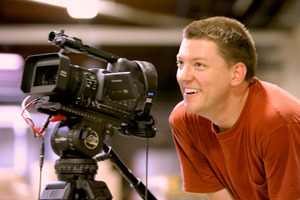 Chris Brown: You know, it’s less autobiographical than people think. Although, whenever my mother is in the audience—she’s been in many audiences—I always say that the mother was modeled after her. [H2N laughs] Just to make her laugh and the other people in the room cringe.
Chris Brown: You know, it’s less autobiographical than people think. Although, whenever my mother is in the audience—she’s been in many audiences—I always say that the mother was modeled after her. [H2N laughs] Just to make her laugh and the other people in the room cringe.
H2N: In all seriousness, where did the idea come from, as it clearly seems to be a work of the imagination—or at least I hope so!
CB: I think the feelings are absolutely true but the facts aren’t true. I certainly have some feelings about Christmas and everything that surrounds it. But really it was more about Fanny for me. I was thinking about that this morning as I was making my coffee. There was something about—and this really sounds pretentious—but there was something about the last decade, the Bush years, there was sort of a pressure cooker of anger about a lot of things, I think. This film is largely the result of that. [CB laughs] And it’s about Fanny. I know a lot of people like Fanny—in my family, friends, in my neighborhood—people who I just wonder how they make it through the day. I know that life is difficult for people with resources, and if you don’t have resources how can you make it through life, how can you do it? And I was wondering about this character Fanny. I write all the time, and I was working on a different character, and this character of the mother said some astonishing, shocking things. Only I didn’t realize she was the mother yet. When I found out that she was the mother of Fanny, the whole film came spooling out instantly.
H2N: What impressed me so much when watching it for the first time was your command and control over all the facets of the process, but particularly with regards to the writing, acting, and editing. Let’s start with the writing. Are you the type of person who sticks to the script as much as possible and doesn’t play the improvisation game when you’re shooting?
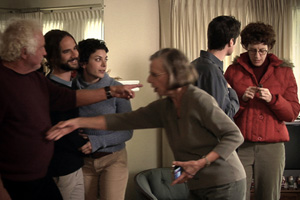 CB: No. I used to be the puppeteer kind of director, the animator kind of director, where “I have my grand vision!” and you sort of have to carry it out. Fortunately, I’m not that kind of hideous, hideous director anymore. [H2N laughs loudly] I write in a vacuum. I really don’t show my work to too many people until right before we’re getting ready to go. But every scene the actors would improve upon, and get rid of my bad dialogue, and just make it so you could actually say these things. Instantly, when we’d rehearse, we’d realize, “Oh, this is terrible, this needs work.” So there’s probably not a scene that wasn’t improved by the actors. I know that’s true.
CB: No. I used to be the puppeteer kind of director, the animator kind of director, where “I have my grand vision!” and you sort of have to carry it out. Fortunately, I’m not that kind of hideous, hideous director anymore. [H2N laughs loudly] I write in a vacuum. I really don’t show my work to too many people until right before we’re getting ready to go. But every scene the actors would improve upon, and get rid of my bad dialogue, and just make it so you could actually say these things. Instantly, when we’d rehearse, we’d realize, “Oh, this is terrible, this needs work.” So there’s probably not a scene that wasn’t improved by the actors. I know that’s true.
H2N: Which leads into the acting. So if you aren’t taking the Shakespearean “stick to the script!” approach, and you did mention the r-word—rehearsal—the performances nonetheless feel like you took some serious time to get what you needed, like it wasn’t a typical indie where everything is, “Hurry up, let’s move on!” after doing three takes. Did you have a pre-production rehearsal process?
CB: I’m sorry to say we did very little pre-production rehearsal, but I had a long shoot. I had 26 days or something. I know that’s still sort of nothing, but actually for me that’s a long shoot. And we were able to do a lot of takes. Like, when I say a lot I mean 30 to 40.
H2N: Wow.
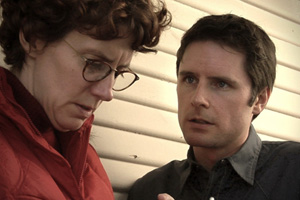 CB: You know, back in the film days I could do three takes and that was it, that was all I could afford. And we could work a scene until it was “really good.” But now, we can shoot a scene until something unexpected and magical happens, and, really, that’s what I’m looking for with every shot. I wanna be surprised, and I want it to lift off the ground in a way that I hadn’t expected. I want the actors to show me something that I wasn’t expecting.
CB: You know, back in the film days I could do three takes and that was it, that was all I could afford. And we could work a scene until it was “really good.” But now, we can shoot a scene until something unexpected and magical happens, and, really, that’s what I’m looking for with every shot. I wanna be surprised, and I want it to lift off the ground in a way that I hadn’t expected. I want the actors to show me something that I wasn’t expecting.
H2N: That does sound like a luxurious number of shooting days, especially for a micro/low-budget indie. Did you do that so as to avoid doing company moves, like rather than cramming two locations into one day you had one full day at each location and much more time to breathe?
CB: Yes, exactly. And, you know, there was one location where I had to reshoot the scene a couple of times ‘cause I couldn’t get it right. All the locations were donated—mostly friends, some family. And everybody was so kind about having us back. But, yeah, we camped out. The house is my grandmother’s house. We camped out at Nanny’s house for a couple weeks. Left everything set up and the whole place was Christmas-ized. [H2N laughs] I can’t see any other way of working at this point. I can work fast. I have to work fast for other things, but I need the time. I think the actors need the time to dig in and find that other level of performance.
H2N: Were these parts written for specific people across the board? Or was it a broad casting process?
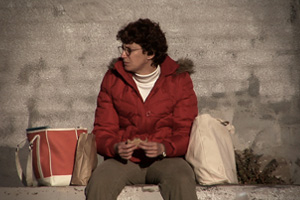 CB: I wrote three of the parts for three of my favorite actors: Jill Pixley, my wife; Colette Keen, who plays Edie; and George Killingsworth, who plays Ronnie. We’ve all worked together a lot. George has been in something like five of my films. I love these people, I wanted to write good parts for them, and I wanted to play with them again! So those parts were theirs. And then I have a lot of actor friends who I plugged in here and there. The other thing, I always allow for a long period of auditioning because it always takes longer than you think, and if you blow it, if you cast the wrong actor you could be plunging your film into the flames. [H2N laughs] It’s the most important thing. If you economize on even a day player, you’re sawing off your foot. Every, every performance, every actor has to be just top-notch. And there’s just no compromising there for me. I just felt I was working with the cream all the way.
CB: I wrote three of the parts for three of my favorite actors: Jill Pixley, my wife; Colette Keen, who plays Edie; and George Killingsworth, who plays Ronnie. We’ve all worked together a lot. George has been in something like five of my films. I love these people, I wanted to write good parts for them, and I wanted to play with them again! So those parts were theirs. And then I have a lot of actor friends who I plugged in here and there. The other thing, I always allow for a long period of auditioning because it always takes longer than you think, and if you blow it, if you cast the wrong actor you could be plunging your film into the flames. [H2N laughs] It’s the most important thing. If you economize on even a day player, you’re sawing off your foot. Every, every performance, every actor has to be just top-notch. And there’s just no compromising there for me. I just felt I was working with the cream all the way.
H2N: Did you stay local and put geographic parameters on your search?
CB: I did. They’re all Bay Area actors. Colette lives on a ranch in Montana, but she used to be a Bay Area actor. They’re all 100% locally grown, sustainable actors. [H2N laughs]
H2N: You talk about the production being a developing process, but does that apply to the editing as well? Or was this a case of you sticking to your original script or vision and connecting the dots?
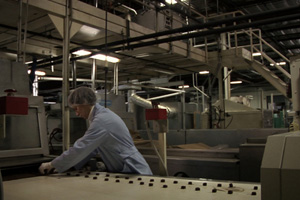 CB: I think the film improved at every stage, actually. I don’t think it was a question of just fulfilling my vision. I had an idea, and it was okay, and then it got better when I cast it, and it got better when we shot it, and it found its form when I cut it. That cliché is really true: the final draft of the script is the cut. I’m an editor by day, and I actually can’t imagine, I can’t imagine turning over that particular task to anyone else. It doesn’t compute to me. I know that most of my favorite films have been made this way, with another editor, of course. But just personally, it’s so much fun to create the film, to find the film, in your footage, shot by shot and moment by moment. It took me a long time to edit, but, like I said, the end result is a better film than what I started with.
CB: I think the film improved at every stage, actually. I don’t think it was a question of just fulfilling my vision. I had an idea, and it was okay, and then it got better when I cast it, and it got better when we shot it, and it found its form when I cut it. That cliché is really true: the final draft of the script is the cut. I’m an editor by day, and I actually can’t imagine, I can’t imagine turning over that particular task to anyone else. It doesn’t compute to me. I know that most of my favorite films have been made this way, with another editor, of course. But just personally, it’s so much fun to create the film, to find the film, in your footage, shot by shot and moment by moment. It took me a long time to edit, but, like I said, the end result is a better film than what I started with.
H2N: So you said that you write in a vacuum. Editing can be an equally solitary experience. Do get eyes on your cuts along the way, or do you prefer to keep it to yourself and trust your instincts?
CB: I stay in the vacuum until a certain moment and then it’s ready, then it’s ready to get some eyes. But until that moment, I’m too insecure with it, really, and I have to sort of protect my own little sandbox. I still wanna play in the sandbox, and I’m gonna make my castle, and at a certain point I invite people into the sandbox. I don’t invite a lot of people in, but I take their advice and their critiques seriously, once they’ve read the script and once they’ve seen the cut. People made pretty valuable contributions, I’d say, to this film.
H2N: Correct me if I’m wrong—maybe it’s my own path to discovering your film—but it seems to me that this thing took a really roundabout route to becoming a part of the indie discussion. Do you agree with that?
CB: Yeah, yeah.
H2N: I forget, where and when did you officially world premiere?
CB: Kansas City, a year-and-a-half ago.
H2N: Which isn’t forever, but it just feels like it took a different path than many similar types of films.
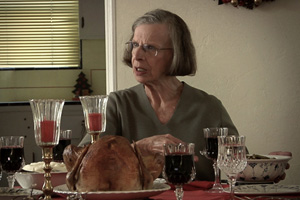 CB: Yep. We sort of crept up from the depths. Kansas City—well, it’s a great festival—my first feature played there, so it’s just a real favorite, and the people there are pretty wonderful. So we were excited to premiere it there. And they gave it sort of instant recognition, they gave it an award there [Best US/International Narrative], and we were really well treated, and then we just sort of said, “Well, this’ll be our circus tour, we’re gonna take our tent from city to city,” and we’ve traveled to most of the festivals we’ve been in, and, you know, I’ve become the Willy Loman of film, taking my little wares from town to town. It’s pretty much a two-person team—Jill and I—we’ve just gone from city to city to try to bang pots and pans and scream and trail through the neighborhoods and bring people in and pass out postcards and put up posters and write to journalists and beg people to come see our movie.
CB: Yep. We sort of crept up from the depths. Kansas City—well, it’s a great festival—my first feature played there, so it’s just a real favorite, and the people there are pretty wonderful. So we were excited to premiere it there. And they gave it sort of instant recognition, they gave it an award there [Best US/International Narrative], and we were really well treated, and then we just sort of said, “Well, this’ll be our circus tour, we’re gonna take our tent from city to city,” and we’ve traveled to most of the festivals we’ve been in, and, you know, I’ve become the Willy Loman of film, taking my little wares from town to town. It’s pretty much a two-person team—Jill and I—we’ve just gone from city to city to try to bang pots and pans and scream and trail through the neighborhoods and bring people in and pass out postcards and put up posters and write to journalists and beg people to come see our movie.
H2N: Especially on the heels of last week’s Sundance announcement—there are a lot of crushed souls sitting at home mourning right now—but I think you’re a great example of someone who has taken a different path to finding your footing in the world. You’ve subsequently picked up even more awards, you’re getting a week-long theatrical run in New York City, which means that you’re going to get a New York Times review as well as many other places… I think all this supports the at times sketchy belief that if you make a good film, it will eventually be seen and appreciated.
CB: I hope that’s true. I think that’s true. I think it’s just crazy persistence, persistence to the point of insanity sometimes. [CB laughs] Where you keep going when there’s no evidence that anything will work out. [both laugh] You just keep marching. “I think that the ocean is just over this pass; we’ll keep marching.” You may be in Utah, but you just sort of keep marching West. We got rejection and rejection after rejection after rejection after rejection, and then when people started accepting the film, of course, other people started accepting the film. We started getting awards. We started getting more awards. We started getting some good reviews. We started getting more good reviews. It’s always that first membrane that has to be broken. It’s very difficult and I think a lot of people lose heart and I just decided, “I’m just gonna keep going, period. I don’t care, I’m just gonna keep sending this film out.” You owe it to the film. You owe it to the film and the actors and the characters. I mean, I love these characters. Even the ones that people find unlovable, and I think their story is important. It sounds so pompous but it’s important to me.
H2N: Your festival run is definitely winding down at this stage. Are you regrouping and turning your attention to a home video release, whether through self-distribution or finding someone who will put it out for you?
CB: Exactly. We’re talking to three different companies just to see if that’s even something we wanna do, if we wanna do that traditional DVD/VOD route. Or if we wanna do it ourselves. I can see some sort of mix being the best option.
There’s one thing I’d like to add, just about the “director’s vision” and all that. I think too much is made of that. But regarding the relationship between actor and director, I strongly feel that the director’s role is that of a caddy to the actor’s pro golfer. And really all you’re there to do is just help the actor. Help the actor get across the course. And that’s it. You’re not a puppeteer. You’re not swinging the club yourself.
— Michael Tully








